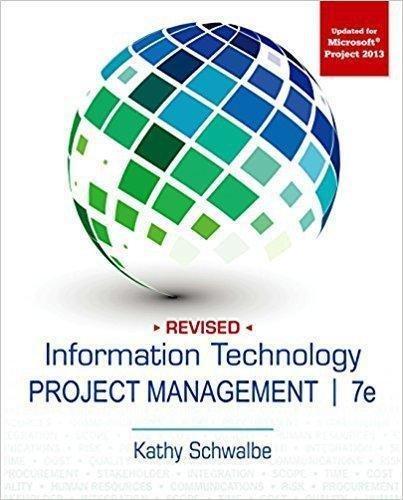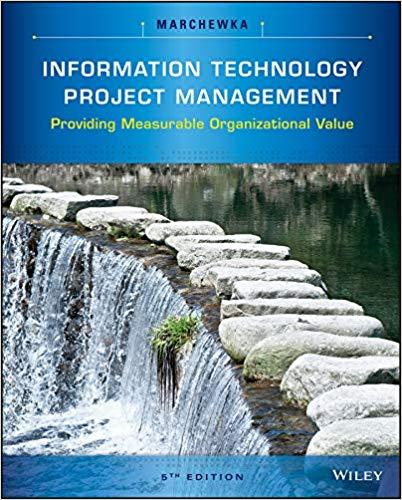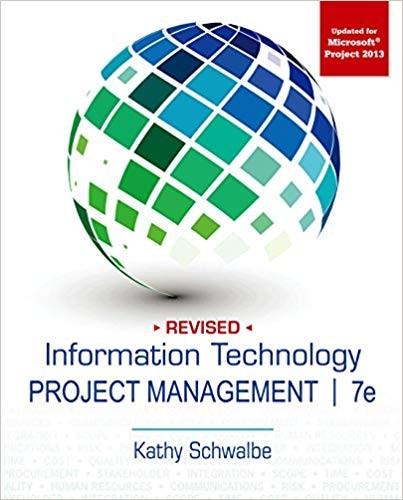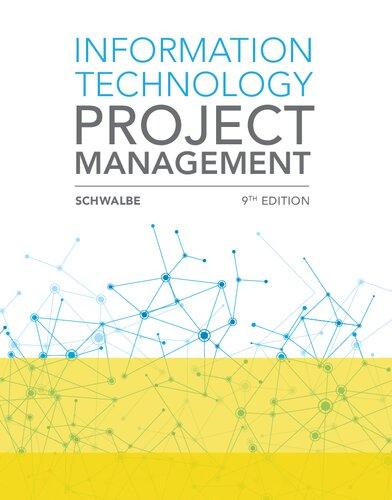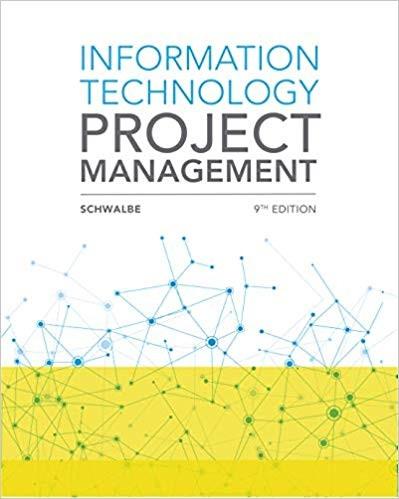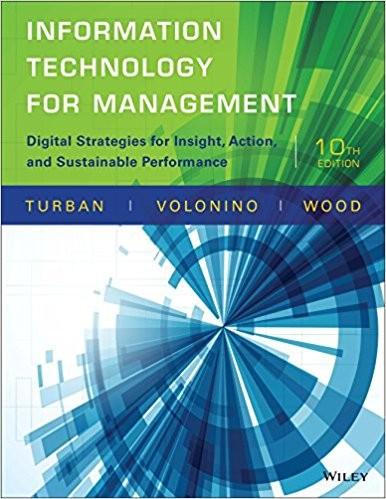Preface
the future of many organizations depends on their ability to harness the power of information technology, and good project managers continue to be in high demand. Colleges have responded to this need by establishing courses in project management and making them part of the information technology, management, engineering, and other curricula. Corporations are investing in continuing education to help develop and deepen the effectiveness of project managers and project teams. this text provides a much-needed framework for teaching courses in project management, especially those that emphasize managing information technology projects. the first seven editions of this text were extremely well received by people in academia and the workplace. the Eighth Edition builds on the strengths of the previous editions and adds new, important information and features.
It’s impossible to read a newspaper, magazine, or web page without hearing about the impact of information technology on our society. Information is traveling faster and being shared by more people than ever before. You can buy just about anything online, surf the web on a mobile phone, or use a wireless Internet connection just about anywhere. Companies have linked their systems together to help them fill orders on time and better serve their customers. Software companies are continually developing new products to help streamline our work and get better results. When technology works well, it is almost invisible. But did it ever occur to you to ask, “Who makes these complex technologies and systems happen?”
Because you’re reading this text, you must have an interest in the “behind-thescenes” aspects of technology. If I’ve done my job well, you’ll begin to see the many innovations society is currently enjoying as the result of thousands of successful information technology projects. In this text, you’ll read about It projects in organizations around the world that went well, including the National University Hospital in Singapore, which used critical chain scheduling to decrease patient admission times by more than 50 percent; retailer Zulily, one of a growing number of organizations developing software in-house to meet their need for speed and innovation; Dell’s green computing project that saves energy and millions of dollars; Google’s driverless car project, striving to reduce traffic accidents and save lives; and many more.
Of course, not all projects are successful. Factors such as time, money, and unrealistic expectations, among many others, can sabotage a promising effort if it is not properly managed. In this text, you’ll also learn from the mistakes made on many projects that were not successful.
I have written this book in an effort to educate you, tomorrow’s project managers, about what will help make a project succeed—and what can make it fail. You’ll also see how projects are used in everyday media, such as television and film, and how companies use best practices in project management. Many readers tell me how much they enjoy reading these real-world examples in the What Went Right?, What
Went Wrong?, Media Snapshot, and Best Practice features. As practitioners know, there is no “one size fits all” solution to managing projects. By seeing how different organizations in different industries successfully implement project management, you can help your organization do the same.
Although project management has been an established field for many years, managing information technology projects requires ideas and information that go beyond standard practices. For example, many information technology projects fail because of a lack of executive support, poor user involvement, and unclear business objectives. this book includes many suggestions for dealing with these issues. New technologies can also aid in managing information technology projects, and examples of using software to assist in project management are included throughout the book.
Information Technology Project Management, Eighth Edition, is the only textbook to apply all 10 project management knowledge areas and all five process groups to information technology projects. As you will learn, the project management knowledge areas are project integration, scope, time, cost, quality, human resource, communications, risk, procurement, and stakeholder management. the five process groups are initiating, planning, executing, monitoring and controlling, and closing.
this text builds on the PMBOK® Guide, Fifth Edition, an American National Standard, to provide a solid framework and context for managing information technology projects. It also includes an appendix, Guide to Using Microsoft Project 2013, that many readers find invaluable.
In addition to the physical text, several resources are available online. Additional case studies, including the one from the Seventh Edition, Manage Your Health, are available, as well as over fifty template files that students can use to create their own project management documents. the author’s personal website (www .kathyschwalbe.com or www.pmtexts.com) also provides additional, up-to-date resources and links related to the field of project management, including topics like Agile, PMP and CAPM certification, simulation software, leadership, mind mapping, sample student projects, and more.
Information Technology Project Management, Eighth Edition, provides practical lessons in project management for students and practitioners alike. By weaving together theory and practice, this text presents an understandable, integrated view of the many concepts, skills, tools, and techniques of information technology project management. the comprehensive design of the text provides a strong foundation for students and practitioners in project management.
n ew to the eI ghth e d I t I on
Building on the success of the previous editions, Information Technology Project Management, Eighth Edition, introduces a uniquely effective combination of features. the main changes in the Eighth Edition include the following:
• A new running case at the end of Chapters 4–13, the ten knowledge area chapters. Instructors often like to assign running cases to reinforce application of key concepts. the “Manage Your Health” running case from the Seventh Edition is provided online along with several additional running cases.
• Updated and additional exercises to enhance student learning and give instructors more options for in-class or out-of-class work.
• Additional content on important topics like leadership and agile.
• New examples that highlight It project management at work in real, newsworthy companies. these timely, relevant examples help illustrate the realworld applications and impact of key project management concepts. they also serve as mini-case stories, suitable for class discussion.
• Many recent studies of It project management and related topics. Summaries of classic, updated, and the most current research throughout the text build a rich context for essential It project management concepts.
• User feedback is incorporated. Based on feedback from reviewers, students, instructors, practitioners, and translators, you’ll see a variety of changes that help clarify information. (this book has been translated into Chinese, Japanese, Russian, and Czech.)
Many people have been practicing some form of project management with little or no formal study in this area. New books and articles are written each year as we discover more about the field and as project management software continues to advance. Because the project management field and the technology industry change rapidly, you cannot assume that what worked even a few years ago is still the best approach today. this text provides up-to-date information on how good project management and effective use of software can help you manage projects, especially information technology projects. Distinct features of this text include its relationship to the Project Management Body of Knowledge, its value in preparing for certification, its detailed guide for using Microsoft Project 2013, its inclusion of running case studies and online templates, its emphasis on It projects, its coverage of several software tools that assist with project management, and its companion website.
Based on PMBOK® Guide, Fifth Edition and Preparing for certification the Project Management Institute (PMI) created the Guide to the Project Management Body of Knowledge (the PMBOK® Guide) as a framework and starting point for understanding project management. It includes an introduction to project management, brief descriptions of all 10 project management knowledge areas, and a glossary of terms. the PMBOK® Guide is, however, just that—a guide. this text uses the PMBOK® Guide, Fifth Edition (2013) as a foundation, but goes beyond it by providing more details, discussing the how and why of the knowledge areas, highlighting additional topics, and providing a real-world context for It project management. this text is an excellent resource for preparing for PMI certifications, such as the Project Management Professional (PMP) and Certified Associate in Project Management (CAPM).
detailed guide to microsoft Project 2013
Software has become a critical tool for helping project managers and their teams effectively manage information technology projects. Information Technology Project Management, Eighth Edition, includes a detailed guide in Appendix A for using the leading project management software on the market—Microsoft Project 2013. Examples that use Project 2013 and other software tools are integrated throughout the text. Appendix A, Guide to Using Microsoft Project 2013, teaches you in a systematic way
to use this powerful software to help in project scope, time, cost, human resource, and communications management.
emphasis on It Projects and Use of Software tools
Most of the examples of projects in this text are based on It projects. Research studies and advice are specific to managing It projects, and include expanded information on agile. Each of the knowledge area chapters includes examples as well as a separate section describing how software can be used to assist in managing that knowledge area. For example, Chapter 5, Project Scope Management, includes examples of using mind maps created with MindView Business software to create a work breakdown structure. Chapter 11, Project Risk Management, shows an example of using Monte Carlo simulation software to help quantify project risk.
exercises, running cases, templates, and Sample documents
Based on feedback from readers, the Eighth Edition continues to provide challenging exercises and running cases to help students apply concepts in each chapter. the text includes more than 50 templates and examples of real project documents that students can use to help them apply their skills to their own projects.
Students can access all of these materials for free through the companion CourseMate product, and for an additional fee, students who purchase the CourseMate product will gain access to a complete, interactive e-book, crossword puzzles, and additional study tools.
a cce SSI ng the c o U r S emate S I te
to access the CourseMate site, open a web browser and go to www.cengagebrain .com. Search by ISBN, author name, or title, and click Create My Account to begin the registration process.
rgan I zat I on and c ontent
Information Technology Project Management, Eighth Edition, is organized into three main sections, which provide a framework for project management, a detailed description of each project management knowledge area, and an appendix of practical information for applying project management. the first three chapters form the first section, which introduces the project management framework and sets the stage for the remaining chapters.
Chapters 4 through 13 form the second section, which describes each of the project management knowledge areas—project integration, scope, time, cost, quality, human resource, communications, risk, procurement, and stakeholder management—in the context of information technology projects. An entire chapter is dedicated to each knowledge area. Each of these chapters includes sections that map to their major processes as described in the PMBOK® Guide, Fifth Edition. For example, the chapter on project quality management includes sections on planning quality management, performing quality assurance, and controlling quality. Additional sections highlight other important concepts related to each knowledge area, such as Six Sigma, testing,
maturity models, and using software to assist in project quality management. Each chapter also includes detailed examples of key project management tools and techniques as applied to information technology projects. For example, the chapter on project integration management includes samples of various project-selection techniques, such as net present value analyses, ROI calculations, payback analyses, and weighted scoring models. the project scope management chapter includes a sample project charter, a project scope statement, and several work breakdown structures for information technology projects.
Appendix A forms the third section of the text, which provides practical information to help you learn how to use the most popular project management software available today. By following the detailed, step-by-step guide in Appendix A, which includes more than 60 screen illustrations, you will learn how to use Project 2013. You can download a free trial from the Microsoft website, use your school or company license, or purchase this powerful software.
Pedagog I cal f eat U re S
Several pedagogical features are included in this text to enhance presentation of the materials so that you can more easily understand the concepts and apply them. throughout the text, emphasis is placed on applying concepts to current, real-world information technology project management.
opening case and case wrap-Up
to set the stage, each chapter begins with an opening case related to the material presented in that chapter. these real-life case scenarios, most of which are based on the author’s experiences, spark student interest and introduce important concepts in a real-world context. As project management concepts and techniques are discussed, they are applied to the opening case and other similar scenarios. Each chapter then closes with a case wrap-up—with some ending successfully and some failing—to further illustrate the real world of project management.
what went right? and what went wrong?
Failures, as much as successes, can be valuable learning experiences. Each chapter of the text includes one or more examples of real information technology projects that went right, as well as examples of projects that went wrong. these examples further illustrate the importance of mastering key concepts in each chapter.
media Snapshot
the world is full of projects. television shows, movies, newspapers, websites, and other media highlight project results that are good and bad. Relating project management concepts to the types of projects highlighted in the media helps you understand the importance of this growing field. Why not get excited about studying project management by seeing its concepts at work in popular television shows, movies, or other media?
Best Practice
Every chapter includes an example of a best practice related to topics in that chapter. For example, Chapter 1 describes best practices written by Robert Butrick, author of The Project Workout, from the Ultimate Business Library’s Best Practice book. He
Another Random Scribd Document with Unrelated Content
Jos hän olisi päässyt kouluun, niin hänellä epäilemättä olisi tietoja enempi kuin mitä niitä hänellä nyt on. Mutta olisiko hän silloin ihmisenä parempi ja hyödyllisempi kuin nytkään? Ja olisiko tietojen hankkiminen silloin tuottanut sitä tyydytystä minkä se nyt, muun työn ja ahdingon lomassa tehtynä on tuottanut?
Hän mietti, kyseli ja vertaili. Oli niin paljon jo hänenkin elämässään tapahtunut sellaista, joka tapahtumahetkellään tuntui ehdottomalta onnettomuudelta, mutta josta nyt jälestäpäin joutui kyselemään että: oliko se onnettomuus vai oliko se — onni?
Ehkä sittenkin on olemassa joku, jolla ihmisiin nähden on omat tarkoituksensa ja joka toteuttaa nämä tarkoituksensa ihmisten vastarinnastakin huolimatta — —. Ja eikö oikeastaan liekin ihmisen onnen pohjana se, että pääsee selville mitä tarkoitusperiä tällä jollakin hänen suhteensa on, ja itsekin alkaa pyrkiä samoja tarkoitusperiä toteuttamaan. Vastarinta kun tuottaa vain tuskaa ja tarpeetonta nöyryytystä.
Kun se joku kuitenkin joka tapauksessa ajaa tahtonsa lävitse.
XX.
Nuorisoseuratalon pihamaa ja pihalle johtava tie oli päätetty hiekoittaa. Lähin hiekan saantipaikka on Hiikolan vainiossa.
Johtokunta velvoitti Laurin ottamaan selkoa, saapiko, ja millä ehdoilla, Hiikolan vainiosta ottaa hiekkaa.
Hiikolassa oli jo pari vuotta ollut isäntänä Alaniemen Miska ja emäntänä Katajiston Maiju. Eikä Lauri ollut vielä kertaakaan tullut heillä käyneeksi. Oli hän kyllä montakin kertaa ajatellut, että pitäisi sielläkin käydä, mutta käymättä se oli tähän saakka jäänyt.
Nyt hänen tuli mentäväksi.
Miska oli vielä työmaalla, kun Lauri tuli. Kylvi apilaa samana päivänä kylvettyyn, huolellisesti muokattuun ohrapeltoon samalla vainiolla josta hiekkaakin otetaan.
Siinä aitaan nojaillessaan Lauri ajoi asiansa. Miska lupasi hiekkaa puolella tavallisesta hinnasta kuorman.
— Kun ei tässä jouda, eikä pystykään, muulla tavalla sitä seuraa eteenpäin auttamaan, niin täytyy edes tällä tavalla, sanoi, taitteli tyhjän siemensäkin kylvyvakkaan ja otti vakan kainaloonsa.
— Mennään nyt tupaan.
Lauri koetti estellä.
— No eihän sulla nyt mihinkään niin ole kiirettä. Mennään nyt sinnekin katsomaan. Kun et ole vielä kertaakaan meillä käynyt ja ennen oltiin niin hyvät ystävät, nuhteli Miska.
— Eipä ole koskaan tullut käytyä, myönsi Lauri. Ei tahdo joutaa, kun on se eukkokin vielä etsittävänä.
— Noo — — Jätä nyt se eukon etsiskely toiseen iltaan. Mennään nyt vain!
Lauri myöntyi, ja lähdettiin tupaa kohti, Miska kylvyvakkaa kantaen ja Lauri pyöräänsä taluttaen.
Rauhallisella mutta lämpimällä tavallaan kertoili Miska kylvöistään. Toista kertaa kasvavaan kauralohkoon oli hän nyt kylvänyt hernettä kauran joukkoon.
— Sinulla on vuoroviljelys järjestettynä?
— Ei se vielä niin järjestettynä ole. Eikä taida hetkeen tullakaan. Jos sen väkirynnäköllä panee yht'äkkiä käyntiin, niin se tulee niin kalliiksi ettei siihen piisaisi piikivetkään. Vähän sinnepäin olen koettanut kokastella, että jos tuon joskus tulevaisuudessa saisi toimeenkin, selitteli Miska.
— Oletko sinä vihantarehua kylvänyt?
— No — olenhan minä vähän sitäkin kylvänyt. Ja kylvän vieläkin kesantopeltoon, kun tästä ehditään siihen saakka. Nyt pitää
ensimäiseksi kylvää loput turnipsia ja istuttaa perunat. Oletko sinä vehnää kylvänyt?
Sitä ei Lauri ollut tehnyt. Miska oli kylvänyt sitäkin vähän kokeeksi.
Juhannusrukiin siemeniä Laurikin oli jo hankkinut.
Ei Miskalla juuri mikään ollut paremmin kuin Laurillakaan. Kartano hänellä oli huonompikin. Mutta sittenkin oli Laurille selvää, että Miska on talonpoika paremmin kuin hän. Heti ulkonaiselta olemukseltaan hän on sitä. Tanakat hiukan eteenpäin kumartuneet hartiat, pitkähkö suortuvina hatun alta riippuva tukka ja ajamaton parran sänki, rauhaisa verkkaisuus ja raskaus liikkeissä, kaikki ne ilmaisivat rehellistä, raskasta raadantaa ja jo huoliakin kokenutta nuorta talonpoikaa. Silmäin ilmekin osoitti lakastumisen oireita.
Tämä viimeinen havainto pani Laurin mielen hiukan apeaksi. Tällainen lakastuminenko se on, ja senkö pitää olla todellisen talonpojan osa — —? Hänen, jonka elämää niin ihannoidaan ja jonka työtä sanotaan niin siunausrikkaaksi?
Huolia ja lakastumisen oireita osoittavat piirteet olivat kuitenkin vielä heikompia ja tuntuivat yhä heikontuvan mitä likemmäksi kotia tultiin. Pohjavärinä silmissä ja koko olemuksessa oli sittenkin kukistumaton varmuus ja työtarmo, sekä leppeä siunausrikas rauhaisuus ja lämpö — juuri se jota Lauri omassa elämässään kipeimmin kaipasi.
Kylvyvakka Miskan kainalossa oli hänen elämänsä vertauskuva. Oman elämänsä vertauskuvaksi Lauri, hiukan säpsähtäen, huomasi — polkupyörän.
— Mennään nyt katsomaan meidän varsaa, sanoi Miska kun tultiin pihaan, ja kylvyvakan kaivon kannelle laskettuaan suuntasi askeleensa tallia kohti. Lauri asetti pyöränsä kaivon seinää vasten ja meni Miskan perässä talliin. Siellä oli karsinassa jonkun päivän vanha kirkassilmäinen varsa. Hännäntynkäänsä heiluttaen se hankaili päätään emänsä kylkeen. Hellyyteen vivahtavalla mielihyvällä Miska silitteli varsan päätä ja kertoi missä oli tamman astuttanut ja selvitti sen ominaisuuksia. Toinen hevonen, myöskin tamma, seisoi pilttuussa. Sen aikoi hän astuttaa tänä kevännä. Hevoset olivat puhtaiksi harjatuita, kohtuullisessa työlihassa ja lauhkean luontoisia. Miska silitteli ja taputteli niitä. Kävi sitten varistamassa niille heiniä ylisiltä.
— Mennään navettaankin katsomaan, koska siellä näytään vielä oltavan, sanoi Miska kun tallista pihalle tulivat.
— Mennään vain, myönsi Lauri.
Navetassa Maiju juuri lopetteli lypsyä.
— Iltaa! Jopa sinutkin viimeinkin vihdoin näkee meillä! huudahti hän vastaukseksi Laurin tervehdykseen. — Kumma kun nyt tulit lähteneeksi?
Lauri selitti miten oli tullut lähteneeksi.
Navetta ei ollut kaikkein uudenaikaisimpia. Kapea, puusta tehty rehupöytä pitkin seinäviertä ja sen etusyrjässä vesiruuhi. Parsien pohja savesta, olkipahna päällä. Toisella sivuseinällä oli vasikka- ja lammaskarsinat, kanakoppi ja perimmäisessä nurkassa kaksi karsinaa, joissa toisessa oli syöttiläspässi ja toisessa sianporsas. Kaiken navetan sisustustyön oli Miska itse tehnyt.
Lehmiä oli viisi, kaikki hyvinvoipia ja puhtaita.
Maiju emäntä oli lopettanut lypsyn, päästänyt sonnustetun hameensa suoraksi ja tuli esittelemään kunkin lehmän lypsykykyä ja muita ominaisuuksia, siveli kädellään lehmäin selkiä ja taputteli hyväillen kaulalle. Lehmät näyttivät pitävän emännästään ja emäntä lehmistään.
Lauri muisti oman navettansa, joka oli parempi kuin tämä — sementti-permanto ja sementti-pöydät — mutta jossa hoitajain ja lehmäin välinen suhde oli vain ruokkijan ja seinään kytkettyjen ruokittavain suhde, ja jossa hän ei ollut koskaan huomannut lehmäin katselevan hoitajiaan eikä hoitajan lehmiään sellaisella mielihyvällä kuin täällä.
Lapsentyttö tuli sanomaan että Mikku on herännyt. Maiju emäntä otti lypsinastiat ja kiiruhti pois. Mennessään vielä varoitti Lauria, että pitää vain tulla tupaan. Laurin huomio kiintyi tyhjässä parressa olevaan seinää vasten nojalleen asetettuun matalareunaiseen ruuheen, jossa oli pieni rautapiikeillä varustettu puomi.
— Mikäs se tuo laitos on? kysyi ja meni luo.
— Se on turpeen repijä, selitti Miska. Koetappas pyörittää!
Lauri tarttui puomissa olevaan kampiin. — Kuinka päin tätä pyöritetään? Näinkö?
— Toisinpäin, että turvekappale painuu pohjaa vasten ja tulee revityksi.
Lauri ymmärsi ja alkoi vääntää. Miska nosteli turvekappaleita puomin päälle. Hieno rauske vain kuului, kun puomin hampaat
raatelivat turvekappaleen toisensa perästä hienoksi.
— Kuka tämän on tehnyt? kysyi Lauri.
— Itse minä olen puutyön, ja tuo meidän kylän seppä raudoitti.
— Tämä on näppärä vehe. Minä olen vain puimakoneella hienontanut, mutta ensi vuodeksi minäkin laitan tällaisen, puhui Lauri vääntäessään.
— Ei, mutta mennään nyt tupaan! huudahti Miska. Et suinkaan sinä ole tänne tullut turvepehkua hienontamaan.
Lauri lakkasi pyörittämästä. Pois mennessään vielä katsahti turpeenrepijäkonetta.
— Ensi vuodeksi laitan minäkin tuollaisen.
Pihalla makasi äes. Äsken sen nähdessään Lauri luuli sitä Hankmoksi.
Nyt hän tuli sitä lähemmin katsoneeksi ja huomasi, ettei se olekaan Hankmo, eikä Vassi eikä Mullistajakaan.
— Mitäs äkeitä tämä on? hän kysyi.
— En tiedä miksi tuon ristisi, naurahti Miska.
— Kuka tämän on tehnyt? uteli Lauri äkeen teriä pyörittäen.
— Minä tulin Tiililän huutokaupassa saaneeksi vanhan rullaäkeen, jolla ei enää ollut mitään virkaa. Sen raameihin me viime kevännä sitten yhteisesti sepän kanssa suunnittelimme ja teimme tällaiset terät.

